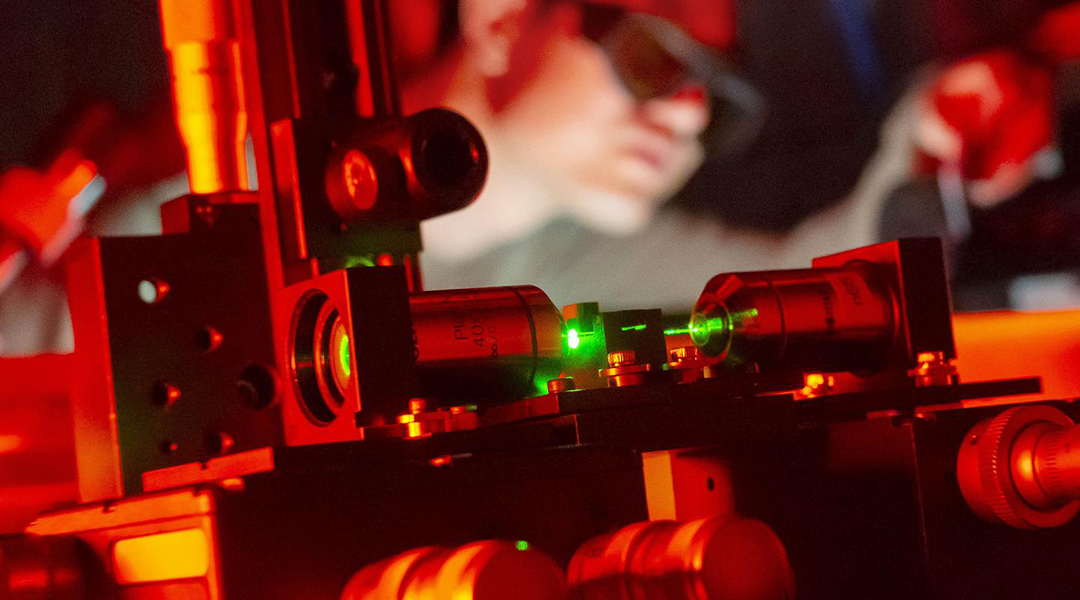Image credit: Jens Meyer (University of Jena)
The interaction between light and matter has led to numerous, ground-breaking scientific advances in the past several years from enhanced optical communications — faster internet and data transmission — to Blue-Ray and DVDs (if they’re still being used), and the development of advanced sensors and spectroscopic instruments in research. Strategies which enhance light–matter interactions and therefore the capabilities of current technologies are, understandably, highly sought-after.
In a recent study published in Advanced Materials, an international team of researchers explored how combining optical fibers with 2D materials could enhance the material’s interactions with light to enable new and exciting applications in sensor development, as well as enhanced optical and quantum technologies — think optical and quantum computers!
2D materials, which are one atom- or molecule-thick, have been a hot topic in science since the explosion of research around graphene took place in 2004. The excitement stems from the fact that whittling down a material to such a thin, base layer results in enhanced properties compared to the bulk material, which scientists have spent more than a decade exploring.
New hybrid optical fibers
In the current study, the team integrated a 2D material made from what are called transition metal dichalcogenides, which possess strong interactions with light, into glass fibers to enhance their capabilities. In the past, combining these two components was very laborious and not suitable for large scale production.
To tackle this challenge, the team developed a method to directly grow the 2D monolayer onto a “guiding core” made from silica optical fibers. “Unlike in the past, we did not apply the 0.5 nm-thick sheet manually, but grew it directly on the fibre,” said Falk Eilenberger of the University of Jena and the Fraunhofer Institute for Applied Optics and Precision Engineering (IOF) in Germany. “This improvement means that the 2D material can be integrated into the fiber more easily and on a large scale.”
By analyzing and controlling growth parameters, the team was able to identify optimal conditions for the production of these hybrid optical fibers through a modified version of a method called chemical vapor deposition. This process is often used in the semiconductor industry to produce thin, high quality films. In general terms, a solid substrate (in this case, the surface of the silica fiber) is exposed under vacuum to one or more volatile precursors, which react on the substrate surface to produce the desired film.
The team demonstrated the chemical vapor deposition of monolayer MoS2 and WS2 crystals on the core of the optical fibers at 700 degrees Celsius. “The pure quartz glass that serves as the substrate withstands the high temperatures extremely well. It is heat-resistant up to 2000 degrees Celsius,” said Professor Markus Schmidt of the Leibniz Institute of Photonic Technology, who developed the fibers. “Their small diameter and flexibility enable a variety of applications.”
The hybrid glass fibers combine the best of both worlds, and were shown to have significantly increased light-matter interactions, says Dr. Antony George, one of the study’s lead authors.
Sensors and non-linear light converters
The researchers demonstrated the potential of their fibers in two distinct applications. The first is in remote sensing and bioanalytics, which leverages the 2D layer’s sensitivity to its environment. For example, external influences affect the fluorescent properties of the 2D material, meaning that in the presence of specific stimuli, for example low concentrations of a gas like carbon monoxide, a green light being sent through the fiber would change to red.
The second application, according to the team, is in new ways of nonlinear light conversion and optical signal processing. While this sounds convoluted, it has really useful applications in analytical techniques such spectroscopy, where monochromatic laser light (lasers can only emit one color or frequency) needs to be converted into visible white light. This aspect of the hybrid fibers also opens doors for applications in quantum electronics and communication.
The direct growth of 2D materials onto guides is opening doors toward the scalable and reproducible functionalization of fibers and other integrated optical systems. “We have brought diverse expertise to this project and we are delighted with the results achieved,” added Eilenberger.
Reference: Gia Quyet Ngo, et al. Scalable Functionalization of Optical Fibers Using Atomically Thin Semiconductors, Advanced Materials (2020). DOI: 10.1002/adma.202003826
Quotes adapted from press release provided by Friedrich-Schiller-Universitaet Jena

















